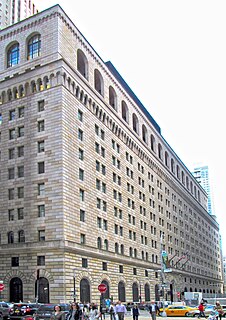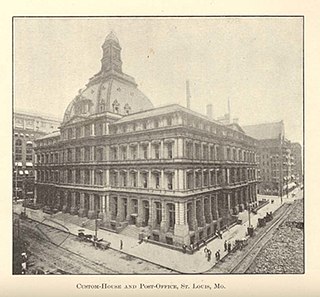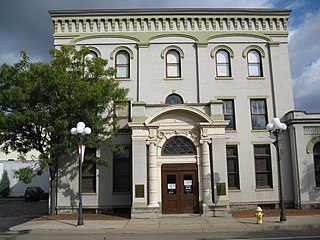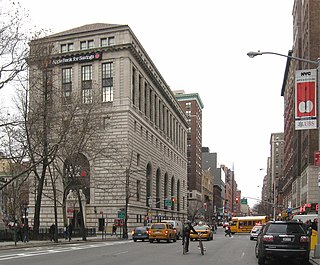
1 Wall Street is a skyscraper in the Financial District of Lower Manhattan, New York City, on the eastern side of Broadway between Wall Street and Exchange Place. 1 Wall Street, designed in the Art Deco style, is 654 feet (199 m) tall and consists of two sections. The original 50-story building was designed by Ralph Thomas Walker of the firm Voorhees, Gmelin and Walker and constructed between 1929 and 1931, while a 36-story annex to the south was designed by successor firm Voorhees, Walker Smith Smith & Haines and built from 1963 to 1965.
14 Wall Street, originally the Bankers Trust Company Building, is a skyscraper at the intersection of Wall Street and Nassau Street in the Financial District of Manhattan in New York City. The building is 540 feet (160 m) tall, with 32 usable floors. It is composed of the original 540-foot tower at the southeastern corner of the site, as well as a shorter annex wrapping around the original tower.

20 Exchange Place, formerly the City Bank–Farmers Trust Building, is a skyscraper in the Financial District of Lower Manhattan in New York City. Completed in 1931, it was designed by Cross & Cross in the Art Deco style as the headquarters of the City Bank–Farmers Trust Company, predecessor of Citigroup. The building, standing at approximately 741 feet (226 m) with 57 usable stories, was one of the city's tallest buildings and the world's tallest stone-clad building at the time of its completion. While 20 Exchange Place was intended to be the world's tallest building at the time of its construction, the Great Depression resulted in the current scaled-back plan.

1 Wall Street Court is a residential building in the Financial District of Manhattan in New York City. The 15-story building, designed by Clinton and Russell in the Renaissance Revival style, was completed in 1904 at the intersection of Wall, Pearl, and Beaver Streets.

48 Wall Street, formerly the Bank of New York & Trust Company Building, is a 32-story, 512-foot-tall (156 m) skyscraper on the corner of Wall Street and William Street in the Financial District of Lower Manhattan in New York City. Built in 1927–1929 in the Neo-Georgian and Colonial Revival styles, it was designed by Benjamin Wistar Morris.

The Federal Reserve Bank of New York Building, also known as 33 Liberty Street, is a building in the Financial District of Lower Manhattan in New York City, which serves as the headquarters of the Federal Reserve Bank of New York. The building occupies the full block between Liberty, William, and Nassau Streets and Maiden Lane; it narrows at its east end, following the footprint of the block.

55 Wall Street, also formerly known as the National City Bank Building, is an eight-story building on Wall Street between William and Hanover streets in the Financial District of Lower Manhattan in New York City. The lowest three stories were completed in either 1841 or 1842 as the four-story Merchants' Exchange and designed by Isaiah Rogers in the Greek Revival style. Between 1907 and 1910, McKim, Mead & White removed the original fourth story and added five floors to create the present building. The facade and part of the interior are New York City designated landmarks, and the building is a National Historic Landmark listed on the National Register of Historic Places (NRHP). The building is also a contributing property to the Wall Street Historic District, listed on the NRHP.

The U.S. Custom House and Post Office is a court house at 815 Olive Street in downtown St. Louis, Missouri.

The Chemung Canal Bank Building is located at 415 East Water Street in Elmira, Chemung County, New York, United States. It is thought to be the oldest commercial building in Elmira. The Chemung Canal opened in 1832 and construction on the bank building began the same year. In 1833 the bank moved into the new building and the Chemung Canal Trust Company was chartered to deposit cash and supply capitol and credit. The building continued to house the bank for seventy-six years. For the following fifty-six years it was home to various local law offices. From 1976 forward, it has been owned by the Chemung County Historical Society. The building is significant for its period architecture and its place in the history of the area. It was named to the National Register of Historic Places in 1978.

The American Bank Note Company Building is a five-story building at 70 Broad Street in the Financial District of Manhattan in New York City. The building was designed by architects Kirby, Petit & Green in the neo-classical style, and contains almost 20,000 square feet (1,900 m2) of space, with offices and residences on the upper floors. The exterior consists of a main facade on Broad Street with two columns, as well as side facades with pilasters on Beaver and Marketfield Streets.

49 Chambers, formerly known as the Emigrant Industrial Savings Bank Building and 51 Chambers Street, is a residential building at 49–51 Chambers Street in the Civic Center neighborhood of Manhattan in New York City. It was built between 1909 and 1912 and was designed by Raymond F. Almirall in the Beaux-Arts style. The building occupies a slightly irregular lot bounded by Chambers Street to the south, Elk Street to the east, and Reade Street to the north.

The Longyear Building is a commercial structure located at 210 North Front Street in Marquette, Michigan. It was listed on the National Register of Historic Places in 2004.

The Wyandotte Odd Fellows Temple is a community building located at 81 Chestnut Street in Wyandotte, Michigan. It was listed on the National Register of Historic Places in 2009. As of 2010, the building serves as the Wyandotte Arts Center.

The Sundberg Block was a commercial building located at 517–523 Iron Street in Negaunee, Michigan, United States. It was listed on the National Register of Historic Places in 2011. It was later demolished in November 2016 and removed from the NRHP in 2020.

The Alma Downtown Historic District is a commercial historic district in Alma, Michigan, roughly located along Superior Street between the Pine River and Prospect Avenue, and along State Street between Center and Downie Streets. Parts of the district were designated a Michigan State Historic Site in 1975, and the entirety was listed on the National Register of Historic Places in 2013. It contains 72 structures, primarily brick commercial buildings, ranging from one to three stories in height and dating from 1874 to the 1960s.

The Cunard Building, also known as the Standard & Poors Building, is a 22-story office building located at 25 Broadway, across from Bowling Green Park in the Financial District of Lower Manhattan in New York City. The Cunard Building was designed in the Italian Renaissance style by Benjamin Wistar Morris, in conjunction with consultants Carrère & Hastings.

The New York Stock Exchange Building, in the Financial District of Lower Manhattan in New York City, serves as the headquarters of the New York Stock Exchange (NYSE). It is composed of two connected structures occupying part of the city block bounded by Wall Street, Broad Street, New Street, and Exchange Place. The central section of the block contains the original structure at 18 Broad Street, designed in the Classical Revival style by George B. Post. The northern section contains a 23-story office annex at 11 Wall Street, designed by Trowbridge & Livingston in a similar style.

The Greenwich Savings Bank Building, also known as the Haier Building and 1356 Broadway, is an office building at 1352–1362 Broadway in the Midtown Manhattan neighborhood of New York City. Constructed as the headquarters of the Greenwich Savings Bank from 1922 to 1924, it occupies a trapezoidal parcel bounded by 36th Street to the south, Sixth Avenue to the east, and Broadway to the west. The Greenwich Savings Bank Building was designed in the Classical Revival style by York and Sawyer.

The Negaunee Downtown Historic District is a commercial historic district located in Negaunee, Michigan, generally located between Peck Street and Rail Street, and between Tobin Street and North Teal Lake Avenue. It was listed on the National Register of Historic Places in 2021.

The Apple Bank Building, also known as the Central Savings Bank Building and 2100 Broadway, is a bank building and residential condominium at 2100–2114 Broadway on the Upper West Side of Manhattan in New York City. Constructed as a branch of the Central Savings Bank from 1926 to 1928, it occupies a trapezoidal city block bounded by 73rd Street to the south, Amsterdam Avenue to the east, 74th Street to the north, and Broadway to the west. The Apple Bank Building was designed by York and Sawyer and patterned after an Italian Renaissance-style palazzo.






















